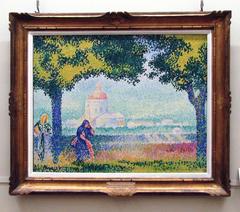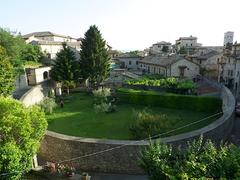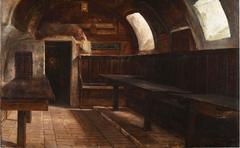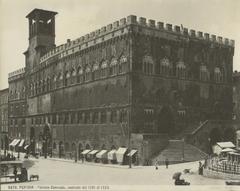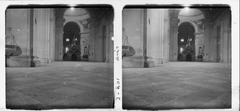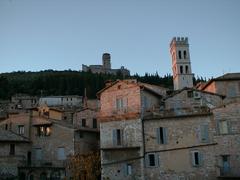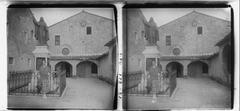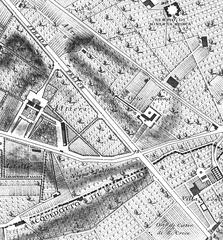
Visiting Basilica Papale di Santa Maria degli Angeli in Porziuncola: Hours, Tickets, and Tips
Date: 17/07/2024
Introduction
The Basilica Papale di Santa Maria degli Angeli in Porziuncola, located in the picturesque town of Assisi, Italy, is an architectural marvel and a site of immense religious and historical significance. This basilica encloses the small and humble Porziuncola Chapel, a sacred place where St. Francis of Assisi, the founder of the Franciscan Order, received his divine calling in 1208. The Porziuncola Chapel is considered the cradle of Franciscan spirituality (Assisi Online).
The construction of the grand basilica began in 1569 under Pope Pius V and was completed in 1679 to protect the sacred chapel and accommodate the growing number of pilgrims (Sacred Destinations). The basilica’s design, influenced by both Renaissance and Baroque styles, features a majestic façade crowned with a statue of the Virgin Mary and a vast interior adorned with intricate details and impressive frescoes (Great Buildings).
This guide aims to provide a comprehensive overview of the Basilica Papale di Santa Maria degli Angeli, covering its rich history, architectural significance, and practical visitor information. Whether you are a pilgrim seeking spiritual renewal or a history enthusiast eager to explore the legacy of St. Francis, this guide will help you make the most of your visit to this remarkable site.
Table of Contents
- Introduction
- Historical Background
- Visiting Hours and Ticket Information
- Travel Tips for Visiting Assisi
- Nearby Attractions
- Accessibility Information
- Special Events and Guided Tours
- Photographic Spots
- FAQ
- Conclusion
Historical Background
Origins and Early History
The origins of the basilica are closely tied to the life of St. Francis of Assisi. The small chapel of Porziuncola, located within the basilica, is where St. Francis received his divine calling in 1208. This chapel, originally a humble structure, was given to St. Francis by the Benedictine monks of Monte Subasio (Assisi Online).
Construction of the Basilica
The construction of the basilica began in 1569 under the direction of Pope Pius V. It was built to enclose the Porziuncola chapel, which had become a significant pilgrimage site. The construction was completed in 1679, and the basilica was consecrated in the same year. The design of the basilica was influenced by the Renaissance architectural style, characterized by its grandiose structure and intricate details (Sacred Destinations).
Architectural Significance
The basilica’s architecture is a blend of Renaissance and Baroque styles. The façade, completed in 1832, features a statue of the Virgin Mary, symbolizing the basilica’s dedication to the Mother of God. The interior of the basilica is equally impressive, with a nave that stretches 126 meters in length and 65 meters in width. The dome, rising to a height of 75 meters, is a testament to the architectural prowess of the period (Great Buildings).
The Porziuncola Chapel
At the heart of the basilica lies the Porziuncola Chapel, a small, simple structure that holds immense historical and spiritual significance. The chapel is believed to date back to the 4th century and was restored by St. Francis himself. It was here that St. Francis founded the Franciscan Order and received the “Pardon of Assisi,” a plenary indulgence granted by Pope Honorius III in 1216. This indulgence, which can be obtained by visiting the chapel on August 2nd, remains a significant aspect of the basilica’s religious importance (Franciscan Media).
The Transito Chapel
Another significant feature within the basilica is the Transito Chapel, which marks the spot where St. Francis died on October 3, 1226. The chapel contains a simple stone slab that serves as a memorial to the saint. The Transito Chapel is a place of quiet reflection and prayer, attracting pilgrims from around the world who come to pay their respects to St. Francis (Catholic News Agency).
The Rose Garden and the Chapel of the Roses
Adjacent to the basilica is the Rose Garden, a site of a miraculous event in the life of St. Francis. According to tradition, St. Francis, seeking penance, threw himself into a thorn bush, which miraculously transformed into a rose bush without thorns. This event is commemorated in the Chapel of the Roses, which contains frescoes depicting the life of St. Francis and the miracle of the roses (Assisi Tourism).
The Basilica’s Role in the Franciscan Order
The basilica holds a central place in the Franciscan Order. It serves as the mother church of the Order of Friars Minor, the branch of the Franciscan Order founded by St. Francis. The basilica is also the site of the annual Chapter of Mats, a gathering of Franciscan friars from around the world, which commemorates the first meeting of the friars convened by St. Francis in 1221 (Franciscan Friars).
Restoration and Preservation Efforts
Over the centuries, the basilica has undergone several restoration and preservation efforts to maintain its structural integrity and historical significance. Notably, the basilica suffered damage during an earthquake in 1832, which led to the reconstruction of the façade. More recently, in 1997, another earthquake caused significant damage to the basilica, prompting extensive restoration work to preserve its historical and architectural heritage (UNESCO).
Visiting Hours and Ticket Information
The basilica is open daily, but visiting hours can vary depending on the season and religious events. It is advisable to check the official website for the most up-to-date information on opening hours and ticket prices. Admission to the basilica is generally free, but there may be charges for guided tours and special exhibitions.
Travel Tips for Visiting Assisi
Assisi is a beautiful town with many historical sites, including the Basilica Papale di Santa Maria degli Angeli. Here are some tips to enhance your visit:
- Plan Ahead: Check the basilica’s schedule for any special events or closures.
- Dress Modestly: As a place of worship, ensure your attire is respectful.
- Guided Tours: Consider taking a guided tour to gain deeper insights into the basilica’s history.
- Time Your Visit: Visit early in the morning or late in the afternoon to avoid crowds.
Nearby Attractions
In addition to the basilica, Assisi offers a wealth of historical and cultural sites, including:
- Basilica of St. Francis: Another must-visit site dedicated to St. Francis.
- Rocca Maggiore: A medieval fortress offering panoramic views of Assisi.
- Temple of Minerva: An ancient Roman temple located in the town’s main square.
Accessibility Information
The basilica is accessible to visitors with disabilities. There are ramps and elevators to assist with mobility, and accessible restrooms are available. It is recommended to contact the basilica in advance for any specific accessibility needs.
Special Events and Guided Tours
The basilica hosts several special events throughout the year, including religious festivals, concerts, and the annual Chapter of Mats. Guided tours are available and can be booked through the official website or local tour operators.
Photographic Spots
Photography is allowed inside the basilica, but be mindful of the rules and respect the sanctity of the place. The exterior façade, the interior nave, and the Rose Garden are popular spots for capturing beautiful photos.
FAQ
Q: What are the opening hours of the basilica?
A: The basilica is open daily, but hours vary. Check the official website for the latest information.
Q: Is there an admission fee?
A: Admission is generally free, but there may be charges for guided tours and special exhibitions.
Q: Can I take photos inside the basilica?
A: Yes, photography is allowed, but be respectful of the rules and the sanctity of the place.
Q: Are there guided tours available?
A: Yes, guided tours are available and can be booked through the official website or local tour operators.
Conclusion
The Basilica Papale di Santa Maria degli Angeli in Porziuncola is a site of immense historical, architectural, and spiritual significance. Its rich history, closely tied to the life of St. Francis of Assisi, and its role as a central place of worship and pilgrimage make it a must-visit destination for those seeking to understand the legacy of one of Christianity’s most revered saints. Plan your visit today and experience the profound beauty and spirituality of this remarkable basilica (Franciscan Media).
Call to Action
For more information, download our mobile app Audiala, check out other related posts, or follow us on social media for updates and travel tips.
References
- Assisi Online. (n.d.). Retrieved from https://www.assisionline.com
- Sacred Destinations. (n.d.). Retrieved from https://www.sacred-destinations.com
- Great Buildings. (n.d.). Retrieved from https://www.greatbuildings.com
- Franciscan Media. (n.d.). Retrieved from https://www.franciscanmedia.org
- Porziuncola. (n.d.). Retrieved from https://www.porziuncola.org
- Assisi Tourism. (n.d.). Retrieved from https://www.assisi-tourism.com

